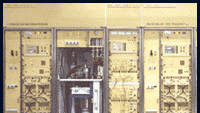UHF TV transmission using IOT amplifiers
The inductive output tube (IOT) is the latest generation grid-type tube for UHF TV power amplifiers. Offering twice the efficiency of klystrons, IOTs have become the solution of choice in recent years for high-power TV transmitters, not only for analog transmissions, but now also for DTV. Indeed, the IOT’s linearity and other intrinsic qualities make it the only appropriate tube for digital applications, whether using 8VSB or COFDM.

This 180kW analog transmitting system from Itelco, in operation in Jakarta, Indonesia, uses TH 770 IOTs from Thales Electron Devices.
The advantages of IOTs
For high-power transmitters of more than 30kW in analog mode, IOT technology offers several advantages over klystrons. Its grid-type tube has far higher efficiency characteristics, leading to considerable energy savings. The grid, located in the electron gun, acts as a flux modulator, thus blocking the electron beam during negative signal emission phases, and therefore significantly increasing efficiency — from around 20 percent on a klystron to 40 percent on a standard IOT.
Higher efficiency, however, is not the only advantage offered by the IOT. It also provides excellent linearity, making it possible to amplify simultaneously several signals without interference.
With FM sound, as used in most current international broadcast systems, the transmitter can be fitted with a single tube to amplify both sound and picture signals. In fact, a single IOT could even amplify three signals at the same time — for instance, one for the image and the other two for either stereo transmission or two different languages.
While solid-state amplifiers meet UHF TV transmission needs, they cannot be used on high-power transmitters of more than 30kW in analog mode or 4kW RMS in digital. This is because they provide much lower efficiency than IOTs and also cost much more.
The professional video industry's #1 source for news, trends and product and tech information. Sign up below.
The difference between IOTs
The IOT’s high efficiency and linearity make it ideal for high-power DTV systems, and broadcasters considering a transition to DTV now are able to choose IOTs that support both analog and digital broadcasts. This sort of operational flexibility is a major advantage for broadcasters, giving them the freedom to choose the type of transmission and facilitating management of their IOTs.
Another differentiator between IOTs is gain; the higher the gain, the less amplification required for the tube’s input power. For example, an IOT with a gain of 23dB actually reduces input power requirements by 50 percent compared with an IOT offering a gain of only 20dB. This results in a considerable reduction in power consumption and simplifies the design and build of the preamplifier.
Depressed-collector IOTs
Although customers can still choose standard IOTs, the more recent depressed-collector IOT offers even higher efficiency. The performance race is on, and the main IOT manufacturers are now rolling out depressed-collector IOTs in either simpler single-stage models, or more complex multi-stage models.
This collector design makes all the difference. Unlike the standard IOT, the depressed-collector IOT is divided into two, three or five stages that are electrically insulated from each other, and each of these stages is independently energized with decreasing negative voltages.
By dividing the collector into two or more stages, the kinetic energy of the electron streams is reduced considerably and, therefore, so is the heat loss. Efficiency on these models is boosted to between 55 percent and 60 percent, which means considerable additional savings in energy consumption.
Choosing an IOT
Given the broad selection of depressed collector IOTs now on the market, users must strike a balance between purchase price and operating costs. In addition to output power, other factors worth considering are:
- Reliability.
- Efficiency.
- Linearity.
- Performance stability over time.
- Operational flexibility in terms of transmission standards.
- Ease of installation.
- Adjustment and maintenance.
- The cooling system used (e.g. oil, water, etc.).
- The ability to change from analog to digital transmission mode and provide excellent efficiency in both modes.
Claude Bel is the IOT products manager and Sylvie Harry is the marketing manager radio TV for Thales Electron Devices.
